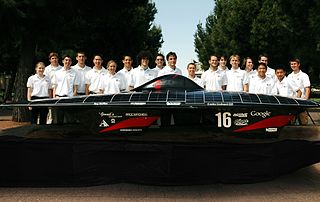
The World Solar Challenge (WSC), since 2013 named Bridgestone World Solar Challenge, is an international event for solar powered cars driving 3000 kilometres through the Australian outback.

A solar vehicle or solar electric vehicle is an electric vehicle powered completely or significantly by direct solar energy. Usually, photovoltaic (PV) cells contained in solar panels convert the sun's energy directly into electric energy.

Nuna is the name of a series of crewed solar powered race cars that have won the World Solar Challenge in Australia seven times: in 2001, 2003, 2005, 2007, 2013, 2015 and 2017. The vehicles are built by students who are part of the "Brunel Solar Team" at the Delft University of Technology in the Netherlands, sponsored by Brunel.

The Stanford Solar Car Project (SSCP) is a student group at Stanford University that designs, builds, tests, and races solar-powered vehicles. The SSCP, a student-run, donation-funded organization, has been building and racing solar-powered vehicles since 1986. It has competed and placed at The World Solar Challenge, the Global Green Challenge, and American Solar Challenge.
The UNSW Solar Racing Team is the solar car racing team of the University of New South Wales in Sydney, Australia. The team currently holds a number of world records and is best known for its participation in the World Solar Challenge (WSC). Since its founding in 1996 by Byron Kennedy, the Sunswift team has built a total of 6 different cars, the most recent of which is Sunswift VI.

The University of Minnesota Solar Vehicle Project, or UMNSVP, is a team of undergraduate students from the University of Minnesota that designs and constructs solar-powered cars. In its 31 years, it has established itself as one of the world's top solar racing teams, and the top Cruiser/Multi-Occupant Vehicle team in the Western Hemisphere, with top-two finishes in eighteen of thirty-four events entered.

The Nuna 3 is a solar car developed by Nuon Solar Team form the Delft University of Technology in 2004-2005 for the 2005 World Solar Challenge.
The Sunraycer was a solar-powered race car designed to compete in the World Solar Challenge, the world's first race featuring solar-powered cars. The Sunraycer was a joint collaboration between General Motors, AeroVironment, and Hughes Aircraft.

The Quiet Achiever, also known as the Holden Solar Trek, was the world's first practical long-distance solar-powered car powered entirely by photovoltaic solar cells.

A solar car is a solar vehicle for use on public roads or race tracks. Solar vehicles are electric vehicles that use self-contained solar cells to provide full or partial power to the vehicle via sunlight. Solar vehicles typically contain a rechargeable battery to help regulate and store the energy from the solar cells and from regenerative braking. Some solar cars can be plugged into external power sources to supplement the power of sunlight used to charge their battery.
Solar car racing refers to competitive races of electric vehicles which are powered by solar energy obtained from solar panels on the surface of the car. The first solar car race was the Tour de Sol in 1985 which led to several similar races in Europe, US and Australia. Such challenges are often entered by universities to develop their students' engineering and technological skills, but many business corporations have entered competitions in the past. A small number of high school teams participate in solar car races designed exclusively for high school students.
The Cal State LA Solar Car Team was a group of engineering students at California State University, Los Angeles that developed the Solar Eagle series of solar cars that competed in solar car races in the United States and Australia.
Nuna 1 was a car powered by solar power, developed by students from the Delft University of Technology.
The following outline is provided as an overview of and topical guide to solar energy:
The 2011 World Solar Challenge was a race from Darwin, Northern Territory to Adelaide, South Australia in Australia. 37 vehicles were entered in the race, and the event was won by a car from Tokai University, Tokyo, Japan.

Sonnenwagen Aachen is a current project by students from RWTH Aachen University and FH Aachen for the development and construction of a solar car, to participate in the World Solar Challenge in Australia. The solar car race with a length of 3022 km from Darwin in Northern Territory to Adelaide in South Australia is known to be the longest solar car race in the world and has celebrated its 30th anniversary in October 2017.
The 1999 World Solar Challenge was one of a biennial series of solar-powered car races, covering about 3,000 km through the Australian Outback, from Darwin, Northern Territory to Adelaide, South Australia.
The 1987 World Solar Challenge was the first international solar-powered car race held in Australia. It covered about 3,000 km (1,900 mi) through the Australian Outback, from Darwin, Northern Territory to Adelaide, South Australia.
The 1990 Hoxan World Solar Challenge was the second international solar-powered car race held in Australia. It covered about 3,000 km (1,900 mi) through the Australian Outback, from Darwin, Northern Territory to Adelaide, South Australia. The event finished at the McLaren Vale.
The 1996 World Solar Challenge was an edition of the trans-Australian solar-powered car race across 3,000 km (1,900 mi) of highway through the Australian Outback from Darwin, Northern Territory to Adelaide, South Australia.








